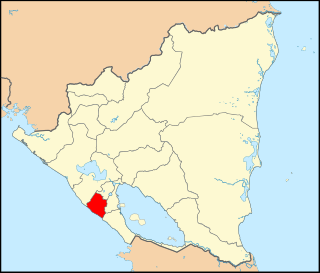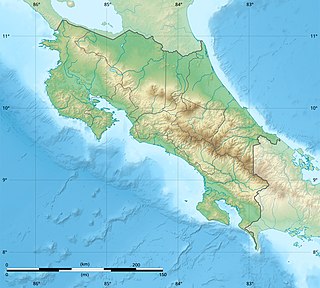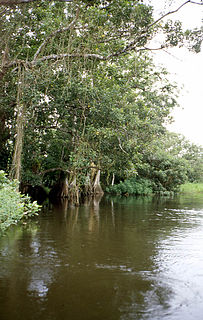
Costa Rica is located on the Central American Isthmus, surrounding the point 10° north of the equator and 84° west of the prime meridian. It borders both the Caribbean Sea and the North Pacific Ocean, with a total of 1,290 km of coastline.

Carazo is a department in Nicaragua. It covers an area of 1,081.40 km² and has a population of 190,769. The capital is Jinotepe.

Bluefields is the capital of the South Caribbean Autonomous Region (RAAS) in Nicaragua. It was also the capital of the former Zelaya Department, which was divided into North and ATLANTIC COST Coast Autonomous Regions. It is located on Bluefields Bay at the mouth of the Escondido River in the municipality of the same name.
La Mosquitia is the easternmost part of Honduras along the Mosquito Coast, which extends into northeastern Nicaragua. It is a region of tropical rainforest, pine savannah, and marsh accessible primarily by water and air. Its population includes indigenous and ethnic groups such as the Miskito, Pech, Rama, Sumo, Garífuna, Ladino, and Creole peoples. La Mosquitia has the largest wilderness area in Central America, consisting of mangrove swamps, lagoons, rivers, savannas and tropical rain forests. The Río Plátano Biosphere Reserve, a World Heritage site, is a part of La Mosquitia.

The Río Plátano Biosphere Reserve is 5,250 km² of preserved land in the La Mosquitia region on the Caribbean coast of Honduras. Most of the land runs along the Río Plátano. The reserve has a number of endangered species and some of Honduras largest sections of forest. It has been a World Heritage site and biosphere reserve since 1982. In 2011, UNESCO placed the reserve on the List of World Heritage in Danger.
The Bosawás Biosphere Reserve in the northern part of state Jinotega, Nicaragua is a hilly tropical forest designated in 1997 as a UNESCO biosphere reserve. At approximately 20,000 km² in size, the reserve comprises about 15% of the nation's total land area making it the second largest rainforest in the Western Hemisphere, after the Amazon in Brazil. Bosawás is largely unexplored, and is extremely rich in biodiversity.

Cerro Kamuk is a mountain in the core of the mountains of La Amistad International Park, in the Cordillera de Talamanca, between the mountain ranges of northern Panama and southeastern Costa Rica. These are one of the highest and wildest mountains of Central America. The diversity of species in this area is unequaled in any other similarly sized reserve in the world. The area protected comprises four national parks clustered together that became La Amistad Biosphere Reserve. UNESCO declared it a natural World Heritage Site in 1983. It is part of the Mesoamerican Biological Corridor, UNESCO's project shared by eight Central American countries to help protect the remaining pristine mountain forest and wildlife of Central America

Los Guatuzos Wildlife Refuge has an area of 437.5 km2 (168.9 sq mi) and is located south of Lake Nicaragua and west of the San Juan River in Nicaragua. Los Guatuzos is a protected area consisting of tropical wetlands, rainforest, and wildlife refuge, it is the only internationally registered tropical wetland area in Nicaragua.

The fauna of Nicaragua is characterized by a very high level of biodiversity. Much of Nicaragua's wildlife lives in protected areas. There are currently 78 protected areas in Nicaragua, covering more than 22,000 square kilometers (8,500 sq mi), or about 17% of its landmass.

Tourism in Nicaragua has grown considerably recently, and it is now the second largest industry in the nation. Nicaraguan President Daniel Ortega has stated his intention to use tourism to combat poverty throughout the country.
Indio Maíz Biological Reserve measures about 4,500 square kilometers and is situated on the southeastern corner of Nicaragua bordering the San Juan River and Costa Rica. It is the second largest expanse of lowland rainforest reserve in Nicaragua and is referred to as "the gem of Central American nature reserves" by UCLA biologists. Indio Maíz is rich in biodiversity, holding a higher number in species of trees, birds, and insects than all of Europe. It is also noted as a popular protected area for tourists.

The protected areas of Nicaragua are areas that have natural beauty or significance and are protected by Nicaragua. Nicaragua has 78 protected areas that cover 22,422 km², about 17.3% of the nations landmass. The National System of Protected Areas (SINAP) is administered by the Ministry of the Environment and Natural Resources (MARENA).

Chocoyero-El Brujo Natural Reserve is located in the municipality of Ticuantepe in the Managua department of Nicaragua. Chocoyero-El Brujo is one of 78 protected areas in Nicaragua, and at just 455 acres (1.8 km2) this tropical forest is one of the smallest in size. Chocoyero-El Brujo was declared a natural reserve in 1993 is managed by the Ministry of the Environment and Natural Resources (MARENA).
Los Chiles is the capital city of the canton of Los Chiles in the province of Alajuela in Costa Rica. It is also the name of the distrito (district) that includes the city. The district of Los Chiles covers an area of 535.93 km², and has a population of 11,064.
Macizos de Peñas Blancas Natural Reserve is a nature reserve in Nicaragua. It is one of the 78 reserves that are under official protection in the country.
Río San Juan Wildlife Refuge is a nature reserve in Nicaragua. It is one of the 78 reserves which are officially under protection in the country. It consists of 430 km2 (170 sq mi).

The Escalante River is a river of Venezuela. It drains into Lake Maracaibo.

The Colorado Parks and Wildlife division of the U.S. State of Colorado manages more than 300 state wildlife areas with a total area of more than 860 square miles (2,230 km2) in the state. The Colorado state wildlife areas are managed for hunting, fishing, observation, management, and preservation of wildlife.













